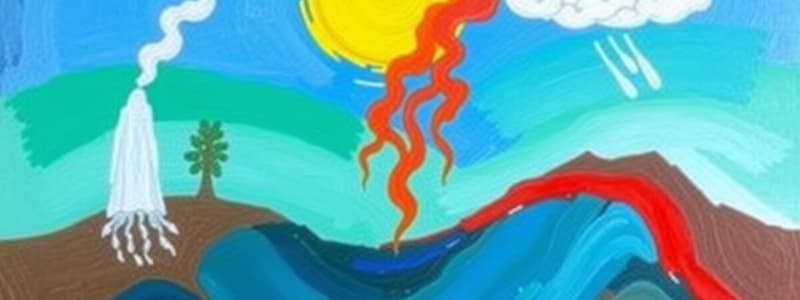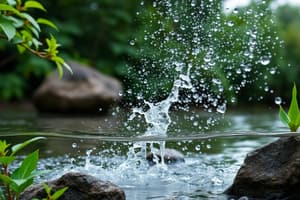Podcast
Questions and Answers
What is the process called when liquid water is turned into water vapor by the sun's heat?
What is the process called when liquid water is turned into water vapor by the sun's heat?
- Transpiration
- Evaporation (correct)
- Precipitation
- Condensation
Which process describes the formation of clouds from water vapor?
Which process describes the formation of clouds from water vapor?
- Sublimation
- Transpiration
- Collection
- Condensation (correct)
What happens during precipitation in the water cycle?
What happens during precipitation in the water cycle?
- Water vapor cools into droplets
- Snow directly transforms into vapor
- Saturated clouds release water back to Earth (correct)
- Groundwater is formed from surface water
Which term refers to the process where water vapor is released into the atmosphere through plants?
Which term refers to the process where water vapor is released into the atmosphere through plants?
What is sublimation in terms of the water cycle?
What is sublimation in terms of the water cycle?
Flashcards
Evaporation
Evaporation
Liquid water turning into water vapor due to heat.
Condensation
Condensation
Water vapor cooling and becoming liquid water droplets forming clouds.
Precipitation
Precipitation
Water falling from clouds as rain, snow, hail, or sleet.
Collection
Collection
Signup and view all the flashcards
Water Cycle
Water Cycle
Signup and view all the flashcards
Study Notes
The Water Cycle
- The water cycle is a continuous process that describes how water moves on, above and below the surface of the Earth.
- Evaporation: The process where the sun's heat turns liquid water in rivers and oceans into water vapor, which rises into the air.
- Condensation: As the water vapor rises, it cools and condenses, forming tiny water droplets which cluster together with dust and other particles to create clouds.
- Precipitation: When clouds become saturated with water droplets, they release the water back to the Earth in the form of rain, hail, or snow.
- Collection: Precipitation replenishes water sources like rivers, lakes, oceans, and seeps into the ground, forming groundwater.
- Transpiration: Plants also contribute to the water cycle by releasing water vapor into the atmosphere through their leaves, a process called transpiration.
- Sublimation: In cold climates, snow can directly transform into water vapor without melting into water, a process known as sublimation.
- The water cycle is a continuous loop, with water constantly moving between these different states and locations.
Studying That Suits You
Use AI to generate personalized quizzes and flashcards to suit your learning preferences.




